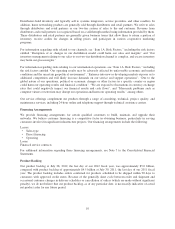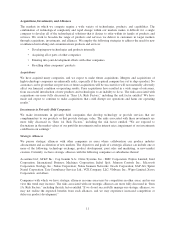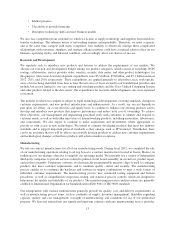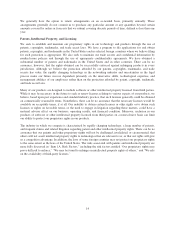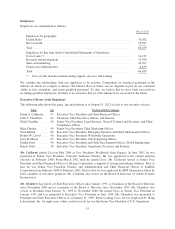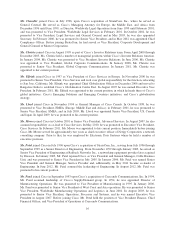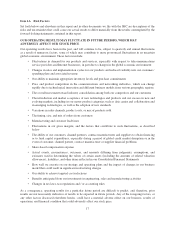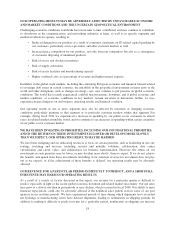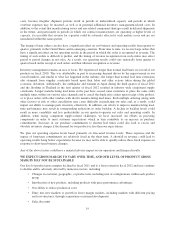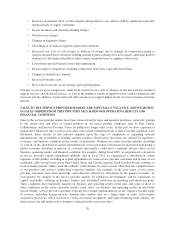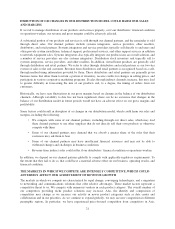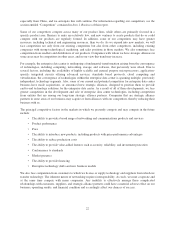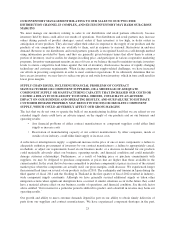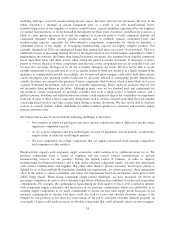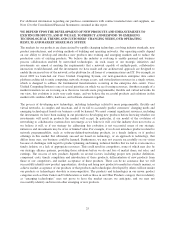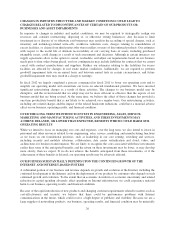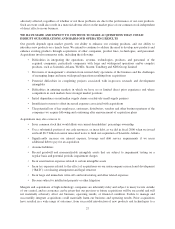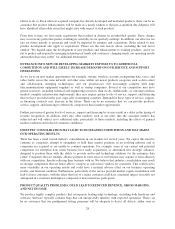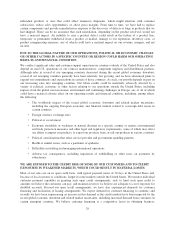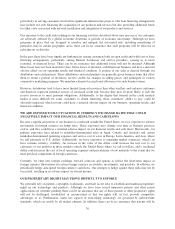Cisco 2012 Annual Report Download - page 28
Download and view the complete annual report
Please find page 28 of the 2012 Cisco annual report below. You can navigate through the pages in the report by either clicking on the pages listed below, or by using the keyword search tool below to find specific information within the annual report.• Increases in material, labor or other manufacturing-related costs, which could be significant especially
during periods of supply constraints
• Excess inventory and inventory holding charges
• Obsolescence charges
• Changes in shipment volume
• The timing of revenue recognition and revenue deferrals
• Increased cost, loss of cost savings or dilution of savings due to changes in component pricing or
charges incurred due to inventory holding periods if parts ordering does not correctly anticipate product
demand or if the financial health of either contract manufacturers or suppliers deteriorates
• Lower than expected benefits from value engineering
• Increased price competition, including competitors from Asia, especially from China
• Changes in distribution channels
• Increased warranty costs
• How well we execute on our strategy and operating plans
Changes in service gross margin may result from various factors such as changes in the mix between technical
support services and advanced services, as well as the timing of technical support service contract initiations and
renewals and the addition of personnel and other resources to support higher levels of service business in future
periods.
SALES TO THE SERVICE PROVIDER MARKET ARE ESPECIALLY VOLATILE, AND WEAKNESS
IN SALES ORDERS FROM THIS INDUSTRY MAY HARM OUR OPERATING RESULTS AND
FINANCIAL CONDITION
Sales to the service provider market have been characterized by large and sporadic purchases, especially relating
to our router sales and sales of certain products in our newer product categories such as Data Center,
Collaboration, and Service Provider Video, in addition to longer sales cycles. In the past, we have experienced
significant weakness in sales to service providers over certain extended periods of time as market conditions have
fluctuated. Sales activity in this industry depends upon the stage of completion of expanding network
infrastructures; the availability of funding; and the extent to which service providers are affected by regulatory,
economic, and business conditions in the country of operations. Weakness in orders from this industry, including
as a result of any slowdown in capital expenditures by service providers (which may be more prevalent during a
global economic downturn or periods of economic uncertainty), could have a material adverse effect on our
business, operating results, and financial condition. For example, during fiscal 2009, we experienced a slowdown
in service provider capital expenditures globally, and in fiscal 2011 we experienced a slowdown in certain
segments of this market, including in capital expenditures by some service provider customers and in sales of our
traditional cable set-top boxes in our then United States and Canada segment. Such slowdowns may continue or
recur in future periods. Orders from this industry could decline for many reasons other than the competitiveness
of our products and services within their respective markets. For example, in the past, many of our service
provider customers have been materially and adversely affected by slowdowns in the general economy, by
overcapacity, by changes in the service provider market, by regulatory developments, and by constraints on
capital availability, resulting in business failures and substantial reductions in spending and expansion plans.
These conditions have materially harmed our business and operating results in the past, and some of these or
other conditions in the service provider market could affect our business and operating results in any future
period. Finally, service provider customers typically have longer implementation cycles; require a broader range
of services, including design services; demand that vendors take on a larger share of risks; often require
acceptance provisions, which can lead to a delay in revenue recognition; and expect financing from vendors. All
these factors can add further risk to business conducted with service providers.
20


